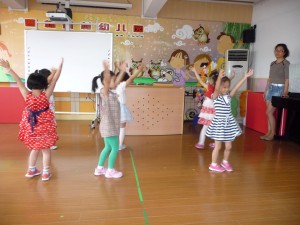 Today is our first visit to an early years setting in China. We are going to a government funded nursery in a Shanghai district. It is a 260 place nursery serving the local community (neighbourhood).
Today is our first visit to an early years setting in China. We are going to a government funded nursery in a Shanghai district. It is a 260 place nursery serving the local community (neighbourhood).
Zhiang, our guide, provides context for our visits based on his own experience and knowledge. It is helpful, for example, to see how the provision of childcare fits into the current Chinese social paradigm, both as an expedient for working parents and as the preparation for children’s education.
It seems to me that the scale and pace of social change in China continues in an almost inexorable movement, reaching far back into its feudal agrarian pre-industrialised past to its present continuing dynamic urban global engagement, where its citizens are trying to come to terms with their former expectations of birth to grave welfare, guaranteed employment and housing provision from the state, albeit not always of the best quality; matched against the reality of existing and aspiring to make a better life for my family (my one child) in this and successive generations, within the uncertain and unchartered territories of enterprise and economic development.
Leaving aside the mind-blowing scale of all of this – Bejing and Shanghai, current populations around 22 million – how to feed, clothe, house, employ, educate, heat, light, transport all these people in a sustainable way, the overarching question is where are the politics headed? What does China mean by communism and what are its paternal (or otherwise) intentions towards its own indigenous people groups and its neighbours and how does it see its future role globally? These are huge and unanswered questions that I continue to consider.
ChIna currently has a population of around 1.4 billion people, 50% of whom live in cities. 20 Years ago this figure was 15%. This is the largest scale and rate of urbanisation in history.
We saw evidence of and heard much about migrant workers. The impoverished masses moving to the cities through economic displacement. These are the men and women building the forests of high rise blocks, 24 hours a day; sweeping Beijing’s streets and waiting tables in its restaurants. They are making ipads, clothing, cars and furniture etc. They are, in the main, relatively uneducated, naïve and often several days journey from home and their family.
Scarce resources are rationed. This includes services. Every citizen has an identity card detailing his/her place of family origin. This determines the location of their entitlement to welfare – education, medical services, housing etc. But here’s the problem, in order to get a job, it is necessary to travel to the city but once there, it is not possible to find a school for your children, a doctor or hospital because your entitlement is back where you came from, not here. So workers have to leave their children at home, cared for by the grandparents. You can always pay for medical help or education but most workers can’t afford this.
The provision that does exist in the cities is over-subscribed. We found it to be of a good standard, well resourced, with qualified and knowledgeable staff. The outdoors environments were well-resourced, safe, well-maintained and welcoming.
The children attend from age 3 to 6 years when they then move on to school. The children we met were happy, engaged and well behaved. There were no children for whom Mandarin Chinese was an additional language.
Children are divided into classes of up to 35 individuals with 2 teachers and 1 assistant. They attend from 8am – 4pm daily with a 2 ½ hour siesta after lunch.
Rather than write an account of our visit, I put it into a poem –
Little stars *
Zhiang led us from the minibus
past railings to security,
clutching our ipads, bags and phones.
You grabbed our hands and pulled us in.
We smiled and clapped while you performed
your polished dance for visitors.
Professionals, we sang our song,
we wound our bobbins, clap, clap, clapped
and pointed to the floor and door.
We came together, hand in hand,
each adult leading their own group,
each circle dancing to the tune.
We waved through doors, we counted cots,
our cameras captured everything.
We headed back into Shanghai.
‘* – the Chinese flag has 1 large star representing China and 4 little stars representing workers, soldiers, peasants, intellectuals.
After our visit to the nursery, we drove to Suzhou ready to tour the Master of Nets garden and to visit a Children’s Development Centre the next day.